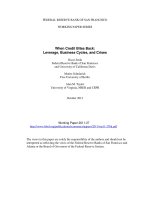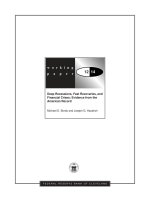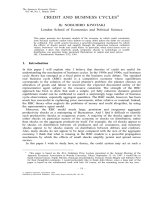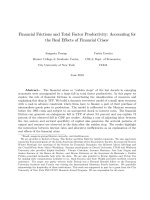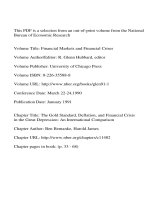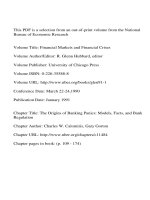business cycles and financial crises
Bạn đang xem bản rút gọn của tài liệu. Xem và tải ngay bản đầy đủ của tài liệu tại đây (3.11 MB, 146 trang )
A. W. Mullineux
Business Cycles and Financial
Crises
Download free books at
Download free eBooks at bookboon.com
2
A. W. Mullineux
Business Cycles and Financial Crises
Download free eBooks at bookboon.com
3
Business Cycles and Financial Crises
© 2011 A. W. Mullineux &
bookboon.com
ISBN 978-87-7681-885-2
Download free eBooks at bookboon.com
Click on the ad to read more
Business Cycles and Financial Crises
4
Contents
Contents
Preface 6
1 e Nature of the Business Cycle 7
1.1 Denitions 7
1.2 e Monte Carlo Hypothesis 11
1.3 Are Business Cycles Symmetric? 18
1.4 e Frisch-Slutsky Hypothesis 23
1.5 Has the Business Cycle Changed Since 1945? 33
Notes 38
2 Business Cycle eory 41
2.1 Introduction 41
2.2 Equilibrium Business Cycle (EBC) Modelling 48
2.3 Nonlinear Cycle eory 56
Notes 61
www.sylvania.com
We do not reinvent
the wheel we reinvent
light.
Fascinating lighting offers an infinite spectrum of
possibilities: Innovative technologies and new
markets provide both opportunities and challenges.
An environment in which your expertise is in high
demand. Enjoy the supportive working atmosphere
within our global group and benefit from international
career paths. Implement sustainable ideas in close
cooperation with other specialists and contribute to
influencing our future. Come and join us in reinventing
light every day.
Light is OSRAM
Download free eBooks at bookboon.com
Click on the ad to read more
Business Cycles and Financial Crises
5
Contents
3 e Financial Instability Hypothesis 63
3.1 Introduction 63
3.2 e Role of Money and Credit in Pre-Keynesian Business Cycle Literature 64
3.3 e Financial Instability Hypothesis (FIH) 71
3.4 Rational Speculative Bubbles 88
3.5 Conclusion 96
Notes 98
4 Towards a eory of Dynamic Economic Development 101
4.1 A Brief Overview of Cycle Modelling 101
4.2 Schumpeter on Economic Evolution 104
4.3 e Long Swing Hypothesis and the Growth Trend 108
4.4 Shackle on the Business Cycle 116
4.5 Goodwin’s Macrodynamics 120
4.6 Concluding Remarks 124
Notes 126
5 e Unnished Research Agenda 128
Notes 133
References 134
360°
thinking
.
© Deloitte & Touche LLP and affiliated entities.
Discover the truth at www.deloitte.ca/careers
Download free eBooks at bookboon.com
Business Cycles and Financial Crises
6
Preface
Preface
My interest in business cycles was rekindled by Professor Jim Ford, my mentor during the rst part of my career at the
University of Birmingham. Since completing my PhD on business cycles in 1983, my lecturing and research had focussed
on money, banking and nance. Jim introduced me to Shackle’s much neglected work on business cycles, which is discussed
in Chapter 4 and emphasises the key role bank lending decisions play in the propogation of business cycles.
e 2007-9 Global Financial Crisis (GFC) was a clear demonstration of the role of bank lending in the propogation of
nancial crises and business cycles and a reminder that Minsky’s nancial stability hypothesis, discussed in Chapter 3,
had also been reglected, but remained highly relevant to modern banking systems. Indeed the onset of the GFC has been
described as a ‘Minsky moment’ when the euphoria of the credit and house price bubbles in the US and elsewhere, turned
to ‘revulsion’ and panic, resulting in a major recession.
is second edition revisits the topic of the role of the banking system in generating nancial crises and business cycles
in the light of the biggest nancial crisis since the 1930s.
Andy Mullineux
Professor of Global Finance
Birmingham Business School
University of Birmingham, UK.
Download free eBooks at bookboon.com
Business Cycles and Financial Crises
7
The Nature of the Business Cycle
1 The Nature of the Business Cycle
1.1 Denitions
Perhaps the most widely quoted and inuential denition is that of Burns and Mitchell (1946, p.l)
1
who state that:
Business cycles are a type of uctuation found in the aggregate economic activity of nations that organise their work
mainly in business enterprises: a cycle consists of expansions occurring at about the same time in many economic
activities, followed by similarly general recessions, contractions, and revivals which merge into the expansion
phase of the next cycle; the sequence of changes is recurrent but not periodic; in duration cycles vary from more
than one year to ten or twelve years; they are not divisible into shorter cycles of similar character with amplitudes
approximating their own.
A number of features of this denition should be highlighted. Firstly, it stresses only two phases of the cycle, the expansionary
and contractionary phases. It will be seen in section 1.2 that the peak or upper turning point and the trough or lower
turning point are not analysed as distinct phases but are merely used to identify business cycles in aggregate economic
time series. Many economists, however, regard the turning points as particular phases requiring separate explanation.
is is especially evident in the discussion of the nancial instability hypothesis, which stresses the role of nancial crises
in terminating the boom phase, in Chapter 3.
e second main feature is the emphasis on the recurrent nature of the business cycle, rather than strict periodicity.
Combined with the wide range of acceptable durations, encompassing both major and minor cycles (Hansen 1951), this
means that cycles vary considerably in both duration and amplitude and that the phases are also likely to vary in length
and intensity. Minor cycles are oen assumed to be the result of inventory cycles (Metzler 1941), but Burns and Mitchell
reject these as separable events as postulated by Schumpeter (1939), among others.
2
Finally, and perhaps most importantly,
they emphasise comovements as evidenced by the clustering of peaks and troughs in many economic series. is is a
feature stressed in numerous subsequent business cycle denitions, a sample of which are discussed below.
e original National Bureau of Economic Research (NBER) work of Burns and Mitchell concentrated on the analysis of
non-detrended data. In the post-war period such analysis has continued but the NBER has also analysed detrended data
in order to identify growth cycles,
3
which tend to be more symmetric than the cycles identied in non-detrended data.
e issue of asymmetry is an important one because it has implications for business cycle modelling procedures; it will
be discussed further in section 1.3.
Concerning the existence of the business cycle, there remain bodies of atheists and agnostics. Fisher (1925, p. 191) is oen
quoted by doubters and disbelievers. He states:
I see no reason to believe in the Business Cycle. It is simply a uctuation about its own mean. And yet the cycle idea is
supposed to have more content than mere variability. It implies a regular succession of similar uctuations constituting
some sort of recurrence, so that, as in the case of the phases of the moon, the tides of the sea, wave motion or pendulum
swing we can forecast the future on the basis of a pattern worked out from past experience, and which we have reason
to believe will be copied in the future.
Download free eBooks at bookboon.com
Business Cycles and Financial Crises
8
The Nature of the Business Cycle
e work done at the NBER has subsequently attempted to show that there is indeed more to the business cycle than mere
variability. Doubters remain, however, and tests of Fisher’s so-called Monte Carlo hypothesis will be discussed in section 1.2.
e NBER view that there is sucient regularity, particularly in comovements, to make the business cycle concept useful
is shared by two of the most distinguished students of cycle theory literature, Haberler (1958, pp. 454-9) and Hansen.
Hansen (1951) notes that some would prefer to substitute ‘uctuations’ for cycles but concludes that the usage of the
term cycles in other sciences does not imply strict regularity. is point is also made by Zarnowitz and Moore (1986) in
a recent review of the NBER methodology.
Lucas (1975) helped to rekindle interest in business cycle theory
4
by reviving the idea of an equilibrium business cycle. e
cycle had tended to be regarded as a disequilibrium phenomenon in the predominantly Keynesian contributions to the
post-war cycle literature. Lucas (1977) discussed the cycle in more general terms and stressed the international generality
of the business cycle phenomenon in decentralised market economies. He concluded (p. 10) that:
with respect to the qualitative behaviour of comovements among series, business cycles are all alike.
And that this:
suggests the possibility of a unied explanation of business cycles, grounded in the general laws governing market economies,
rather than in political or institutional characteristics specic to particular countries or periods.
e intention here is not to deny that political or institutional characteristics can inuence actual cycle realisations and
help account for their variation between countries and periods. It is rather to stress the existence of general laws that
ensure that a market economy subjected to shocks will evolve cyclically. Research that aims to gauge the extent to which
the US business cycle has changed since the Second World War is reviewed in section 1.5.
Sargent (1979, p. 254) attempts to formalise a denition of the business cycle using time series analysis. He rst analyses
individual aggregate economic time series and arrives at two denitions. Firstly:
A variable possesses a cycle of a given frequency if its covariogram displays damped oscillations of that frequency, which
is equivalent with the condition that the non-stochastic part of the dierence equation has a pair of complex roots with
argument… equal to the frequency in question. A single series is said to contain a business cycle if the cycle in question
has periodicity of from about two to four years (NBER minor cycles) or about eight years (NBER major cycles).
Secondly, Sargent argues that a cycle in a single series is marked by the occurrence of a peak in the spectral density of that
series. Although not equivalent to the rst denition, Sargent (1979, Ch. XI) shows that it usually leads to a denition of
the cycle close to the rst one.




